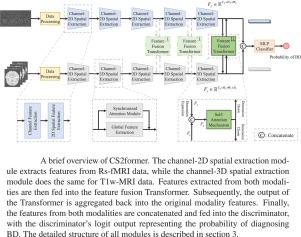CS2former:基于双通道空间特征提取模块的双相情感障碍多模态特征融合变压器
IF 4.9
2区 医学
Q1 ENGINEERING, BIOMEDICAL
Computerized Medical Imaging and Graphics
Pub Date : 2025-08-28
DOI:10.1016/j.compmedimag.2025.102632
引用次数: 0
摘要
双相情感障碍(BD)是一种以显著情绪波动为特征的衰弱性精神疾病,由于其临床复杂性,对准确诊断提出了重大挑战。本文介绍了CS2former,这是一种利用Transformer模型中的双通道空间特征提取模块从静息状态功能MRI (Rs-fMRI)和t1加权MRI (T1w-MRI)数据诊断BD的新方法。CS2former采用通道- 2d空间特征聚合模块将Rs-fMRI的通道和空间信息解耦,而通道- 3d空间注意模块与同步注意模块(SAM)同时计算T1w-MRI特征图的注意力。这种双重提取策略与Transformer相结合,增强了跨模态的特性集成。我们在OpenfMRI和我们收集的两个数据集上的实验结果证明了CS2former的优越性能。值得注意的是,与基线模型相比,该模型在我们数据集上的平衡精度提高了10.8%,在OpenfMRI数据集上的平衡精度提高了5.7%。这些结果强调了CS2former在多模态特征融合方面的创新及其在提高双相障碍诊断效率和准确性方面的潜力。本文章由计算机程序翻译,如有差异,请以英文原文为准。

CS2former: Multimodal feature fusion transformer with dual channel-spatial feature extraction module for bipolar disorder diagnosis
Bipolar disorder (BD) is a debilitating mental illness characterized by significant mood swings, posing a substantial challenge for accurate diagnosis due to its clinical complexity. This paper presents CS2former, a novel approach leveraging a dual channel-spatial feature extraction module within a Transformer model to diagnose BD from resting-state functional MRI (Rs-fMRI) and T1-weighted MRI (T1w-MRI) data. CS2former employs a Channel-2D Spatial Feature Aggregation Module to decouple channel and spatial information from Rs-fMRI, while a Channel-3D Spatial Attention Module with Synchronized Attention Module (SAM) concurrently computes attention for T1w-MRI feature maps. This dual extraction strategy is coupled with a Transformer, enhancing feature integration across modalities. Our experimental results on two datasets, including the OpenfMRI and our collected datasets, demonstrate CS2former’s superior performance. Notably, the model achieves a 10.8% higher Balanced Accuracy on our dataset and a 5.7% improvement on the OpenfMRI dataset compared to the baseline models. These results underscore CS2former’s innovation in multimodal feature fusion and its potential to elevate the efficiency and accuracy of BD diagnosis.
求助全文
通过发布文献求助,成功后即可免费获取论文全文。
去求助
来源期刊
CiteScore
10.70
自引率
3.50%
发文量
71
审稿时长
26 days
期刊介绍:
The purpose of the journal Computerized Medical Imaging and Graphics is to act as a source for the exchange of research results concerning algorithmic advances, development, and application of digital imaging in disease detection, diagnosis, intervention, prevention, precision medicine, and population health. Included in the journal will be articles on novel computerized imaging or visualization techniques, including artificial intelligence and machine learning, augmented reality for surgical planning and guidance, big biomedical data visualization, computer-aided diagnosis, computerized-robotic surgery, image-guided therapy, imaging scanning and reconstruction, mobile and tele-imaging, radiomics, and imaging integration and modeling with other information relevant to digital health. The types of biomedical imaging include: magnetic resonance, computed tomography, ultrasound, nuclear medicine, X-ray, microwave, optical and multi-photon microscopy, video and sensory imaging, and the convergence of biomedical images with other non-imaging datasets.

 求助内容:
求助内容: 应助结果提醒方式:
应助结果提醒方式:


